![]()
![]()
![]()
Use LEFT and RIGHT arrow keys to navigate between flashcards;
Use UP and DOWN arrow keys to flip the card;
H to show hint;
A reads text to speech;
68 Cards in this Set
- Front
- Back
|
Fleas are in what class and what order?
|
Class insecta
Order Siphonaptera |
|
|
Flies are in what class and what order?
|
Class Insecta
Order Diptera |
|
|
Despite which class and order they belong to all Arthropods are
|
Invertebrates
|
|
|
Invertebrates have
|
chitinous exoskeleton
segmented body and jointed limbs |
|
|
Arthropods growth and maturation is accomplished via what 3 types of development
|
Incomplete metamorphosis and complete metamorphosis as well as ametabolus
|
|
|
What arthropods have incomplete metamorphosis?
|
true bugs, lice, mites, and ticks.
|
|
|
What arthropods have complete metamorphosis?
|
fleas, flies
|
|
|
What are the general stages of incomplete metamorphosis?
|
egg to larva, to pupa, to adult
|
|
|
Most fleas and flies spend the most of their time what stage?
|
larva
|
|
|
List some examples of deleterious effects of direct host-ectoparasite interactions.
|
blood loss (exanguination), myiasis9tissue destrcution by maggots), skin inflammation and pruritus, toxic and allergic responses, suoffocation.
|
|
|
List some examples of indirect - host ectoparasite interactions
|
self multilation, secondary infection, stress, decreased production, entomophobia.
|
|
|
List some examples of indirect- host- ectoparasite-pathogen-interactions
|
vectors of disease-causing organisms such as nematodes, fungi, protozoa, bacteria, viruses.
|
|
|
Arthropods can act as what 2 vectors
|
Mechanical and Biological vectors
|
|
|
Mechanical vectors occur when
|
bugs crawl through feces, eggs or come in contact with other organisms and then pass off to animal. NO development or multiplication
|
|
|
Biological vectors occur when
|
when infective organisms undergo development or multiply within the vector. IE flies, bugs, fleas, lice ticks. Transmission after prolonged time span
|
|
|
Class Insecta is also called
|
Hexapoda
|
|
|
Class Insecta constitutes what percentage of arthropods
|
90%
31 orders |
|
|
Members of class insecta have what general characteristics
|
3 pairs of legs in adults,
3 body parts 2 pairs of wings (except flies, fleas and lice) 2 eyes Pair of antennae |
|
|
Fleas are from what Order
|
Siphonaptera
|
|
|
How many described species of fleas are there?
|
2500
|
|
|
Fleas are
|
laterally flattened wingless, obligate blood feeding insects.
|
|
|
What stage of fleas are parasitic
|
Male and female.
|
|
|
Fleas are host ______?
|
Preferential
|
|
|
Flea blood feeding causes
|
inflammation, pruritius, anemia or cutaneous hypersensitivity
|
|
|
Adult fleas have what morphology?
|
1/8 to 1/4 in size,
lateraly flattnend piercing-sucking mouthparts, identifiable adult morphology |
|
|
What structures for geuns identification are used for fleas?
|
combs, ctenidia (genal or pronotal)
eyes, mesopleural rod ocular bristle in front or below eye |
|
|
Flea general life cycle is typically
|
35 days
mostly in environment |
|
|
Flea mating and egg laying occurs on the
|
host
|
|
|
Flea larvae pupate where
|
within the cocoon and adult emerges ready to feed within 24 hours
|
|
|
Generally the adult fleas spends its life
|
on the host
|
|
|
The Common Fleas of Veterinary Importance are from what families?
|
Pulicidae
Ceratophyllidae |
|
|
Flea Family Pulicidae have what genera
|
ctenocephalidies, Pulex, Xenopsylla, Echidnophaga
|
|
|
Flea Family Ceratophyllidae have what genera
|
Nosopysllus, Petopsylla, Cedopsylla, Orchopease, Oropsylla
|
|
|
Ctenocephalides has what 2 species
|
C. felis
C. canis |
|
|
C. felis and C. canis both have what morphology
|
both genal and pronotol cones
|
|
|
C. felis's true resistance may be overshadowed by
|
reproductive capacity and feeding habits.
|
|
|
Fleas can act as
|
intermediate host of parasitic worms
biological vector mechanical vector |
|
|
Tapeworm proper name
|
dipylidium caninum
|
|
|
Flea larvae receive tapeworm eggs how?
|
by ingesting them from host feces.
|
|
|
In the adult flea what larval stages of Diphylidium caninum develop
|
L1 to L3 (infective stage
|
|
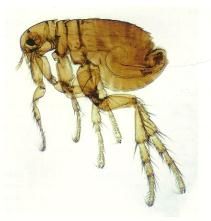
|
Pulex irritans
|
|
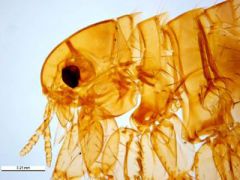
|
Pulex irritans
|
|
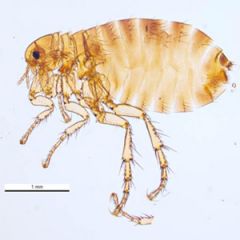
|
Pulex irritans
|
|
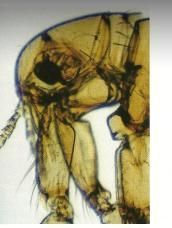
|
Pulex irritans
|
|
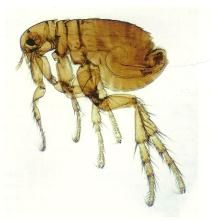
|
Pulex irritans
|
|
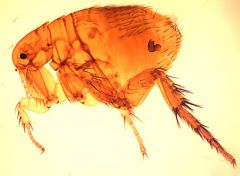
|
Xenopsylla
|
|
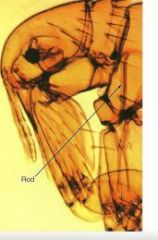
|
Xenopsylla
|
|
|
Fleas can act as intermidate host of parasitic worms and what other type?
|
biological and mechanical vector of bacteria.
Bartonella henselae Mycoplasma haemofelis (hemobartonella) |
|
|
:"human flea"
|
P. irritans and P. simulans
|
|
|
P. irritans can be found on what species?
|
humans, dogs, cats, swine and wildlife
|
|
|
Adult Pulex fleas do not have what?
|
pronotal and genal combs
|
|
|
Pulex adult fleas resemble what other flea and what are the differences?
|
Xenopsylla
Pulex do not have mesopleuron rod. |
|
|
Pulex life cycle similar to
|
ctenocephalides
|
|
|
Pulex control via
|
modern pesticides - very susceptible
|
|
|
Pulex fleas are involved in what diseases?
|
Rickettsia typhi
murine typhus - hosts, rodents Yersinia pestis - plague |
|
|
Xenopsylla cheopis is also called
|
oriental rat flea - found in port cities
|
|
|
Xenopsylla morphology
|
No pronotal or genal comb, but does have a mesopleuron rod
|
|
|
Xenopsylla fleas are vectors for
|
Yersinia pestis
Rickettsia typhi |
|
|
Plague in the US is usually transmitted via
|
rodent flea, not dog or cat
|
|
|
Echidnophaga gallinacea important in
|
domestic poultry
|
|
|
Echidnophaga gallinacea can kill young chicks by
|
esanguination
|
|
|
Echidnophaga gallinacea morphology
|
angular head and no combs
|
|
|
Echidonophaga attaches to host like
|
tick and remains attached.
|
|
|
Echidonophaga can potentially transmit
|
plague and murine typhus, but because stay attached, not major vector
|
|
|
Rodent fleas
|
Nosopsyllus fasciatus
Leptosyllus segnis cediopsylla simplex Orchopeas howardii Oropsylla montana |
|
|
Flea Allergy Dermatitis is primary caused by
|
Ctenocephalides and Pulex
|
|
|
FAD is a
|
true hypersensitivity
|
|
|
For dogs with FAD what type of flea control is not good
|
The ones that require the flea to bite the animal
|

